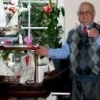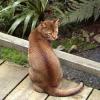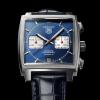-
Posts
692 -
Joined
-
Last visited
Reputation Activity
-
 rvchima got a reaction from GuntherMT in USS Arleigh Burke by rvchima - FINISHED - BlueJacket Shipcrafters - 1/16" scale - guided missile destroyer
rvchima got a reaction from GuntherMT in USS Arleigh Burke by rvchima - FINISHED - BlueJacket Shipcrafters - 1/16" scale - guided missile destroyer
More Small Parts
5" gun mount & boat crane
2 double life raft canisters, 3 reels, 2 SATCOM antennas, 11 single life raft canisters
-
 rvchima got a reaction from FriedClams in USS Arleigh Burke by rvchima - FINISHED - BlueJacket Shipcrafters - 1/16" scale - guided missile destroyer
rvchima got a reaction from FriedClams in USS Arleigh Burke by rvchima - FINISHED - BlueJacket Shipcrafters - 1/16" scale - guided missile destroyer
It's Not Done Yet
Lest you think that I'm almost done with this model, here's a photo of the parts that still need to be attached. Sigh...
-
 rvchima got a reaction from JPett in USS Arleigh Burke by rvchima - FINISHED - BlueJacket Shipcrafters - 1/16" scale - guided missile destroyer
rvchima got a reaction from JPett in USS Arleigh Burke by rvchima - FINISHED - BlueJacket Shipcrafters - 1/16" scale - guided missile destroyer
Painting 38 days, 120 hours
My previous post about pin striping tape turned out to be a moot question. I was ready to paint and my tape still had not arrived. I painted the top of the hull with Testors Haze gray, masked that off, painted the bottom with Rustoleum Colonial red, masked that off, and painted the waterline with Testors flat black. I kept a couple of samples going to make sure that everything was compatible. The results were perfect. No touch up necessary.
Then I masked the hull off and painted the deck with Testors Euro gray.
The kit comes with self-adhesive stencils for the Helicopter landing markings. They are a little tricky to apply because when you remove the backing everything flops loose. Nevertheless, they went down OK. I airbrushed maybe 6 light coats of flat white, using a hair dryer between coats.
Removing the stencils was pure terror. If I screwed up there was no recourse. But the results looked pretty good.
Here's everything stacked up so far. It's starting to look like a real ship!
-
 rvchima got a reaction from JPett in USS Arleigh Burke by rvchima - FINISHED - BlueJacket Shipcrafters - 1/16" scale - guided missile destroyer
rvchima got a reaction from JPett in USS Arleigh Burke by rvchima - FINISHED - BlueJacket Shipcrafters - 1/16" scale - guided missile destroyer
Harpoon Missile Racks
These Harpoon missile racks couldn't have been much harder to build. I spent about 9 hours on the two of them. Each rack has 28 pieces:
6 photo-etched brass frames laminated into 3 double pieces. 4 cast metal tubes that don't fit in the frames without sanding. 2 pieces of brass wire along the bottom. 3 tiny photo-etched brass struts on the bottom. 8 brass pieces for the legs. I glued these together with CA. 1 styrene blast sheild. 4 cast metal feet. Does that add up to 28? I've lost count.
They do look pretty good when they're done.
-
 rvchima got a reaction from JPett in USS Arleigh Burke by rvchima - FINISHED - BlueJacket Shipcrafters - 1/16" scale - guided missile destroyer
rvchima got a reaction from JPett in USS Arleigh Burke by rvchima - FINISHED - BlueJacket Shipcrafters - 1/16" scale - guided missile destroyer
Masking tape model
I've seen ship models made of card, bone, and toothpicks, so I thought it would be fun to make one out of masking tape.
Ha ha, only joking. I REALLY did not want to mask off the entire forward superstructure to paint the decks, so I half-masked (half-assed) it and tried to paint it with a brush. I watched every boring video on Youtube about brush painting, and the results still weren't up to my generally low standards. So I bit the bullet and masked the hole thing off.
Here's the result after a little retouching. There is very little difference between the Haze gray walls and the Euro gray decks.
-
 rvchima got a reaction from JPett in USS Arleigh Burke by rvchima - FINISHED - BlueJacket Shipcrafters - 1/16" scale - guided missile destroyer
rvchima got a reaction from JPett in USS Arleigh Burke by rvchima - FINISHED - BlueJacket Shipcrafters - 1/16" scale - guided missile destroyer
PROPS!
Did I tell you that I ordered propellers? The kit has you building your own using Britannia metal hubs, photo-etched brass blades, and gold paint. I didn't bother. Instead I ordered a pair of 1-inch diameter Raboesch brass power props from The Model Dockyard. They cost about 38 USD including shipping, but worth every D. I honestly think Bluejacket should include these props with the kit, even if they have to increase the price. At least make them available as an option.
-
 rvchima got a reaction from JPett in USS Arleigh Burke by rvchima - FINISHED - BlueJacket Shipcrafters - 1/16" scale - guided missile destroyer
rvchima got a reaction from JPett in USS Arleigh Burke by rvchima - FINISHED - BlueJacket Shipcrafters - 1/16" scale - guided missile destroyer
Miscellaneous Small Parts
3 missile directors
2 MK 32 torpedo tubes
2 SBROC launchers
2 R2-D2 droids
-
 rvchima got a reaction from schooner in USS Arleigh Burke by rvchima - FINISHED - BlueJacket Shipcrafters - 1/16" scale - guided missile destroyer
rvchima got a reaction from schooner in USS Arleigh Burke by rvchima - FINISHED - BlueJacket Shipcrafters - 1/16" scale - guided missile destroyer
Dapping tool
The instructions said to shape the missile director (radar) dishes with a dapping tool. I Googled "dapping tool" and discovered that my wife had the female part of one in the kitchen, and I had the male part in my bolt drawer. (Please don't tell my wife.)
-
 rvchima got a reaction from FriedClams in USS Arleigh Burke by rvchima - FINISHED - BlueJacket Shipcrafters - 1/16" scale - guided missile destroyer
rvchima got a reaction from FriedClams in USS Arleigh Burke by rvchima - FINISHED - BlueJacket Shipcrafters - 1/16" scale - guided missile destroyer
Top Coat
I put 3 coats of Krylon Matte finish on everything. Nothing melted or dissolved. Most of the marks on the deck disappeared. I am really glad I did this.
-
 rvchima got a reaction from Tadeusz43 in USS Arleigh Burke by rvchima - FINISHED - BlueJacket Shipcrafters - 1/16" scale - guided missile destroyer
rvchima got a reaction from Tadeusz43 in USS Arleigh Burke by rvchima - FINISHED - BlueJacket Shipcrafters - 1/16" scale - guided missile destroyer
PROPS!
Did I tell you that I ordered propellers? The kit has you building your own using Britannia metal hubs, photo-etched brass blades, and gold paint. I didn't bother. Instead I ordered a pair of 1-inch diameter Raboesch brass power props from The Model Dockyard. They cost about 38 USD including shipping, but worth every D. I honestly think Bluejacket should include these props with the kit, even if they have to increase the price. At least make them available as an option.
-
 rvchima got a reaction from Tadeusz43 in USS Arleigh Burke by rvchima - FINISHED - BlueJacket Shipcrafters - 1/16" scale - guided missile destroyer
rvchima got a reaction from Tadeusz43 in USS Arleigh Burke by rvchima - FINISHED - BlueJacket Shipcrafters - 1/16" scale - guided missile destroyer
Miscellaneous Small Parts
3 missile directors
2 MK 32 torpedo tubes
2 SBROC launchers
2 R2-D2 droids
-
 rvchima got a reaction from FriedClams in USS Arleigh Burke by rvchima - FINISHED - BlueJacket Shipcrafters - 1/16" scale - guided missile destroyer
rvchima got a reaction from FriedClams in USS Arleigh Burke by rvchima - FINISHED - BlueJacket Shipcrafters - 1/16" scale - guided missile destroyer
Dapping tool
The instructions said to shape the missile director (radar) dishes with a dapping tool. I Googled "dapping tool" and discovered that my wife had the female part of one in the kitchen, and I had the male part in my bolt drawer. (Please don't tell my wife.)
-
 rvchima got a reaction from Canute in USS Arleigh Burke by rvchima - FINISHED - BlueJacket Shipcrafters - 1/16" scale - guided missile destroyer
rvchima got a reaction from Canute in USS Arleigh Burke by rvchima - FINISHED - BlueJacket Shipcrafters - 1/16" scale - guided missile destroyer
Top Coat
I put 3 coats of Krylon Matte finish on everything. Nothing melted or dissolved. Most of the marks on the deck disappeared. I am really glad I did this.
-
 rvchima got a reaction from FriedClams in USS Arleigh Burke by rvchima - FINISHED - BlueJacket Shipcrafters - 1/16" scale - guided missile destroyer
rvchima got a reaction from FriedClams in USS Arleigh Burke by rvchima - FINISHED - BlueJacket Shipcrafters - 1/16" scale - guided missile destroyer
PROPS!
Did I tell you that I ordered propellers? The kit has you building your own using Britannia metal hubs, photo-etched brass blades, and gold paint. I didn't bother. Instead I ordered a pair of 1-inch diameter Raboesch brass power props from The Model Dockyard. They cost about 38 USD including shipping, but worth every D. I honestly think Bluejacket should include these props with the kit, even if they have to increase the price. At least make them available as an option.
-
 rvchima got a reaction from CDW in USS Arleigh Burke by rvchima - FINISHED - BlueJacket Shipcrafters - 1/16" scale - guided missile destroyer
rvchima got a reaction from CDW in USS Arleigh Burke by rvchima - FINISHED - BlueJacket Shipcrafters - 1/16" scale - guided missile destroyer
Miscellaneous Small Parts
3 missile directors
2 MK 32 torpedo tubes
2 SBROC launchers
2 R2-D2 droids
-
 rvchima got a reaction from src in USS Arleigh Burke by rvchima - FINISHED - BlueJacket Shipcrafters - 1/16" scale - guided missile destroyer
rvchima got a reaction from src in USS Arleigh Burke by rvchima - FINISHED - BlueJacket Shipcrafters - 1/16" scale - guided missile destroyer
Dapping tool
The instructions said to shape the missile director (radar) dishes with a dapping tool. I Googled "dapping tool" and discovered that my wife had the female part of one in the kitchen, and I had the male part in my bolt drawer. (Please don't tell my wife.)
-
 rvchima got a reaction from hof00 in USS Arleigh Burke by rvchima - FINISHED - BlueJacket Shipcrafters - 1/16" scale - guided missile destroyer
rvchima got a reaction from hof00 in USS Arleigh Burke by rvchima - FINISHED - BlueJacket Shipcrafters - 1/16" scale - guided missile destroyer
PROPS!
Did I tell you that I ordered propellers? The kit has you building your own using Britannia metal hubs, photo-etched brass blades, and gold paint. I didn't bother. Instead I ordered a pair of 1-inch diameter Raboesch brass power props from The Model Dockyard. They cost about 38 USD including shipping, but worth every D. I honestly think Bluejacket should include these props with the kit, even if they have to increase the price. At least make them available as an option.
-
 rvchima got a reaction from FriedClams in USS Arleigh Burke by rvchima - FINISHED - BlueJacket Shipcrafters - 1/16" scale - guided missile destroyer
rvchima got a reaction from FriedClams in USS Arleigh Burke by rvchima - FINISHED - BlueJacket Shipcrafters - 1/16" scale - guided missile destroyer
Miscellaneous Small Parts
3 missile directors
2 MK 32 torpedo tubes
2 SBROC launchers
2 R2-D2 droids
-
 rvchima got a reaction from Canute in USS Arleigh Burke by rvchima - FINISHED - BlueJacket Shipcrafters - 1/16" scale - guided missile destroyer
rvchima got a reaction from Canute in USS Arleigh Burke by rvchima - FINISHED - BlueJacket Shipcrafters - 1/16" scale - guided missile destroyer
Dapping tool
The instructions said to shape the missile director (radar) dishes with a dapping tool. I Googled "dapping tool" and discovered that my wife had the female part of one in the kitchen, and I had the male part in my bolt drawer. (Please don't tell my wife.)
-
 rvchima got a reaction from Captain Slog in USS Arleigh Burke by rvchima - FINISHED - BlueJacket Shipcrafters - 1/16" scale - guided missile destroyer
rvchima got a reaction from Captain Slog in USS Arleigh Burke by rvchima - FINISHED - BlueJacket Shipcrafters - 1/16" scale - guided missile destroyer
Top Coat
I put 3 coats of Krylon Matte finish on everything. Nothing melted or dissolved. Most of the marks on the deck disappeared. I am really glad I did this.
-
 rvchima got a reaction from Canute in USS Arleigh Burke by rvchima - FINISHED - BlueJacket Shipcrafters - 1/16" scale - guided missile destroyer
rvchima got a reaction from Canute in USS Arleigh Burke by rvchima - FINISHED - BlueJacket Shipcrafters - 1/16" scale - guided missile destroyer
PROPS!
Did I tell you that I ordered propellers? The kit has you building your own using Britannia metal hubs, photo-etched brass blades, and gold paint. I didn't bother. Instead I ordered a pair of 1-inch diameter Raboesch brass power props from The Model Dockyard. They cost about 38 USD including shipping, but worth every D. I honestly think Bluejacket should include these props with the kit, even if they have to increase the price. At least make them available as an option.
-
 rvchima got a reaction from Canute in USS Arleigh Burke by rvchima - FINISHED - BlueJacket Shipcrafters - 1/16" scale - guided missile destroyer
rvchima got a reaction from Canute in USS Arleigh Burke by rvchima - FINISHED - BlueJacket Shipcrafters - 1/16" scale - guided missile destroyer
Miscellaneous Small Parts
3 missile directors
2 MK 32 torpedo tubes
2 SBROC launchers
2 R2-D2 droids
-
 rvchima got a reaction from Captain Slog in USS Arleigh Burke by rvchima - FINISHED - BlueJacket Shipcrafters - 1/16" scale - guided missile destroyer
rvchima got a reaction from Captain Slog in USS Arleigh Burke by rvchima - FINISHED - BlueJacket Shipcrafters - 1/16" scale - guided missile destroyer
Dapping tool
The instructions said to shape the missile director (radar) dishes with a dapping tool. I Googled "dapping tool" and discovered that my wife had the female part of one in the kitchen, and I had the male part in my bolt drawer. (Please don't tell my wife.)
-
 rvchima got a reaction from mtaylor in USS Arleigh Burke by rvchima - FINISHED - BlueJacket Shipcrafters - 1/16" scale - guided missile destroyer
rvchima got a reaction from mtaylor in USS Arleigh Burke by rvchima - FINISHED - BlueJacket Shipcrafters - 1/16" scale - guided missile destroyer
Top Coat
I put 3 coats of Krylon Matte finish on everything. Nothing melted or dissolved. Most of the marks on the deck disappeared. I am really glad I did this.
-
 rvchima reacted to Daniel Dusek in Dusek Ship Kits-news+info
rvchima reacted to Daniel Dusek in Dusek Ship Kits-news+info
Hi Sjors.
Thanks. Of course the kit will contain english manual (unfortunatelly not Dutch ).
Last two days I spend with 3D modeling of archangel Michael figurehead. I will try to print it next week.
Daniel











